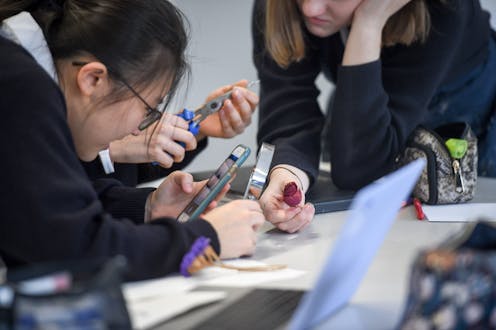
When the UK took its first steps out of national lockdown in April and schools reopened, education secretary Gavin Williamson announced the implementation of the behaviour hubs programme. And as part of this push to develop a school culture “where good behaviour is the norm”, he pushed for banning smartphones in schools.
Williamson claims that phones distract from healthy exercise and, as he put it, good old-fashioned play. And he says they act as a breeding ground for cyberbullying. Getting rid of them will, to his mind, create calm and orderly environments that facilitate learning. “While it is for every school to make its own policy,” he wrote, “I firmly believe that mobile phones should not be used or seen during the school day, and will be backing headteachers who implement such policies.”
The difficulty that teachers face is that there are often conflicting assessments of the risks and benefits of the constant influx of new devices in schools. As we found in our recent study, guidance for educators on how to navigate all this is limited. And there is no robust evaluation of the effect of school policies that restrict school-time smartphone use and there is limited evidence on how these policies are implemented in schools. So how can teachers approach this controversial subject?
We believe the best way to start is to reframe the smartphone itself. Rather than just a phone, it is more accurately described as a powerful pocket computer. It contains, among other things, a writing tool, a calculator and a huge encyclopaedia.
Suggesting that children use smartphones in ways that help them learn, therefore, seems hardly radical. The perennial debate about banning phones needs to shift to thinking about how best to help schools better design school phone policies and practices that can enrich their pupils’ learning, health and wellbeing. And for that, we can start by looking at the evidence on phone use by young people.
We know that most adolescents own a smartphone. When used appropriately and in moderation, they can provide multiple benefits in terms of learning, behaviour and connection with peers. There is also evidence that technology use in classrooms can support learning and attainment.
The operative word here, though, is “moderation”. Excessive use of smartphones (and other digital devices) can lead to heightened anxiety and depression, neglecting other activities, conflict with peers, poor sleep habits and an increased exposure to cyberbullying.
Then there’s everything we don’t yet fully understand about the impact – good or bad – that smartphone use may have on children. No one does. This has been reflected in recent research briefings and reports published by the UK government: they recognise the risks and benefits of phone use, and report that it is essential that schools are better supported to make decisions about their use in school with evidence-based guidance.
Playing catch-up
To investigate existing school positions on phone and media use, we interviewed and did workshops with more than 100 teenagers across years nine to 13, along with teachers, community workers and international specialists in school policies and health interventions.
We found that teachers tend to be scared of phones. Most of them said this was because they didn’t know how pupils are using their phones during school hours. Amid pressures regarding assessment, safeguarding and attendance, phones are simply not a priority. Issuing a blanket ban is often just the easiest option.
Teachers too recognise the benefits, as well as the risks, of smartphone use. But, crucially, they don’t have the necessary guidance, skills and tools to parse seemingly contradictory information. As one teacher put it: “Do we allow it, do we embrace it, do we engage students with it, or do we completely ignore it?”
Different approaches
This is, of course, a worldwide challenge. Looking at how different institutions in different cultural settings are tackling it is instructive. Often, similar motivations give rise to very different approaches.
The mould-breaking Agora school in Roermond, in the Netherlands, for example, allows ubiquitous phone use. Their position is that teenagers won’t learn how to use their phones in a beneficial way if they have to leave them in their lockers.
By contrast, governments in Australia, France and Canada are urging schools to restrict phone use during the day in a bid to improve academic outcomes and decrease bullying.
Teachers need a new type of training that helps them to critically evaluate – with confidence - both academic evidence and breaking news. Working with their students in deciding how and when phones can be used could prove fruitful too.
Accessing information
Academic research takes time to publish, data is often incomprehensible to non-experts and papers reporting on findings are often subject to expensive journal subscription prices. Professional development providers, trusts and organisations therefore must do more to make it easier for teachers to access the information they need to make decisions.
New data alone, though, isn’t enough. Researchers need be prepared to translate their evidence in ways that educators can actually use to design better school policies and practices.
The children’s author and former children’s laureate Michael Rosen recently made the point that “we are living in an incredible time: whole libraries, vast banks of knowledge and multimedia resources are available to us via an object that fits in our pockets”.
That doesn’t sound like something educators should ignore. Findings from our study add to the current debate by suggesting that new evidence and new types of teacher training are urgently needed to help schools make informed decisions about phone use in schools.
Victoria Goodyear receives funding from Wellcome Trust.
Kathleen Armour receives funding from Wellcome Trust
Miranda Pallan receives funding from the UK National Institute for Health Research and is a member of the Labour Party.
* This article was originally published at The Conversation

0 Comments